In the ever-evolving landscape of advertising and digital media, the rise of deepfake technology has brought forth a new wave of concerns and challenges. Recently, the utilization of deepfake technology in advertisements featuring celebrities like Smriti Mandhana and Sara Tendulkar has ignited a nationwide debate on the potential risks associated with this rapidly advancing technology. As the public becomes increasingly exposed to these digitally manipulated advertisements, the government has stepped in, issuing warnings about the possible dangers and implications.
The Rise of Deepfake Technology in Advertising
Deepfake technology, powered by artificial intelligence, allows for the creation of highly realistic fake videos and images by superimposing one person’s likeness onto another. In the realm of advertising, this has opened up new possibilities for marketers but has also raised ethical concerns. The recent surge in deepfake advertisements featuring cricket sensation Smriti Mandhana and emerging influencer Sara Tendulkar has brought these concerns to the forefront.

Celebrity Endorsements and the Deepfake Dilemma
Celebrities lend their credibility and influence to brands through endorsements, creating a powerful connection with their fan base. However, the use of deepfake technology in advertisements blurs the line between reality and fiction, potentially causing reputational damage to both the celebrities involved and the brands they endorse. Smriti Mandhana, known for her prowess on the cricket field, and Sara Tendulkar, the daughter of legendary cricketer Sachin Tendulkar, found themselves unwittingly cast in these digitally altered advertisements, prompting widespread concern.

Government Intervention and Warning
Recognizing the potential risks associated with the proliferation of deepfake advertisements, the government has issued a stern warning to both advertisers and the general public. Officials have emphasized the need for stringent regulations to govern the use of deepfake technology in advertising, highlighting the potential harm it can cause to individuals’ reputations and the broader implications for public trust.
Ethical Considerations and Public Perception
The ethical implications of using deepfake technology in advertising are vast and multifaceted. Beyond the potential harm to celebrities, there is a broader concern about the erosion of trust in media and advertising. As consumers become increasingly skeptical of the authenticity of content, there is a risk of undermining the credibility of genuine endorsements and advertisements.
Industry Response and Self-Regulation
In response to the government’s warning, industry stakeholders, including advertising agencies and technology companies, are now exploring ways to self-regulate the use of deepfake technology. Discussions are underway to establish clear guidelines and ethical standards that can govern the responsible use of AI-driven tools in the creation of advertising content.
Looking Ahead: Balancing Innovation and Responsibility
The current debate surrounding deepfake advertisements featuring Smriti Mandhana and Sara Tendulkar underscores the delicate balance between innovation and responsibility in the digital age. As technology continues to advance, there is a pressing need for comprehensive regulations that safeguard the integrity of digital content while fostering a culture of ethical and responsible advertising.
Conclusion
the government’s warning on the potential risks associated with deepfake ads featuring celebrities marks a pivotal moment in the ongoing discourse on the ethical use of technology in advertising. The outcome of this debate will likely shape the future landscape of digital marketing, influencing how brands engage with celebrities and consumers in an era where distinguishing reality from fiction has become an ever more complex challenge.






















